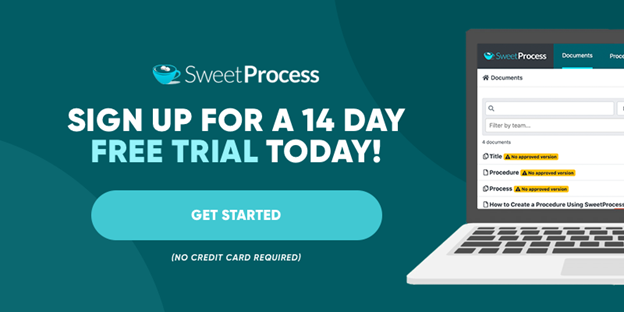Last Updated on October 30, 2024 by Owen McGab Enaohwo

Do you work incredibly hard, yet struggle to achieve your goals? Maybe you realize your skills haven’t improved much when you reflect on the last five or ten years. Or perhaps you’re struggling with ways to accomplish your goals in the next few months.
The truth is that most people drift all their lives from one job to another or accomplish very little while struggling to get more done.
The most important step you can take is to set goals. Anybody who wants to achieve anything in life must learn to set well-defined goals—doing so gives you a clear direction for your behavior and planning.
And the most informed create SMART goals (or goals that are specific, measurable, attainable, relevant, and timely). The SMART goals framework was proposed in the 1980s by George Doran in Management Review and has since been used by thousands of successful companies.
Here’s everything you need to know about this structured approach to business:
SMART Goals: A Definitive Guide | Chapter Index
Chapter 1: What Are SMART Goals?
Chapter 2: Why Most People Fail to Achieve Their Goals
Chapter 3: Why Are SMART Goals Important?
Chapter 4: Examples of SMART Goals
Chapter 5: Templates to Help You Create SMART Goals Easily
Chapter 6: Actionable Ways to Achieve SMART Goals
Chapter 7: Alternative Acronyms
Chapter 8: SMART Goals vs. OKRs
Chapter 9: Your SMART Goal FAQs Answered
Chapter 10: Let SweetProcess Help You Set and Achieve Your SMART Goals
Chapter 1: What Are SMART Goals?

SMART goals acronym (standing for specific, measurable, attainable, relevant, and time-bound) ensures your goals are clear. Though it has origins in the business world, it applies to anything you aspire to bring to life today.
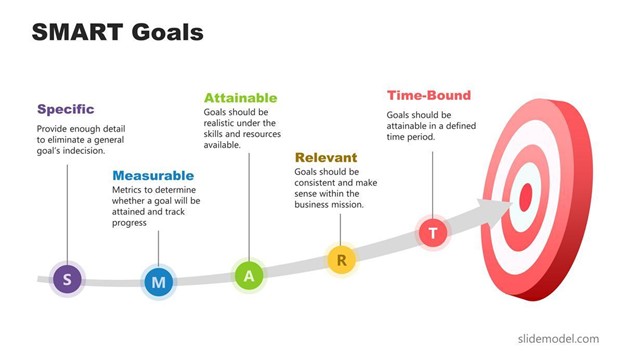
The SMART goal-setting approach has been championed by professionals and managers globally across numerous sectors and industries.
The SMART framework can help you achieve both your long-term and short-term goals. To set your achievable goals each of them should be:
- Specific (simple, significant)
- Measurable (motivating, meaningful)
- Attainable (achievable, agreed)
- Relevant (realistic, reasonable)
- Time-bound (time-sensitive, timely)
In his published 1981 editorial in Management Review, “There’s a SMART Way to Write Management’s Goals and Objectives”, George T. Doran (a consultant and former director of corporate planning for Washington Water Power Company) is credited for outlining the foundation of what has now become the concept of SMART goals.
Let’s first go through each letter:
1. Specific
Ambiguous goals don’t make good goals. They’re even more confusing. But setting clear and specific goals can help you achieve what you want in life.
For instance, instead of saying “I want a better body” you could be more specific and say, “I want to shed twenty pounds by the end of next month to flaunt my new bikini.”
A specific goal is better and easier to achieve than a vague one.
When setting a SMART goal, try and answer these five questions:
- What do I want my goal to accomplish?
- Why is my goal important?
- Who (else) is involved in setting my goal?
- Where is my goal located?
- Which resources will I need to achieve my goal?
2. Measurable
To keep you motivated (and focused on the bigger picture), you have to track the progress of your goal. Tracking helps you set indicators (or milestones) that you can celebrate when you achieve them—or reevaluate when your goal fails you.
That’s why you should ensure your goal is measurable and easier to evaluate before you can begin tracking its progress.

A measurable goal should answer three questions, including:
- How much (is the goal)?
- How many (are the goals I’m progressively tracking)?
- How will I know when (a goal) is achieved?
3. Attainable
It‘s tempting to set an impossible goal. Too many people have fallen into this unfavorable trap. Impossible goals will only push you too far, and you’ll most likely lose the thrill along the way or in the future.
Instead of going for the impossible goal, set a simple yet challenging goal that you can easily achieve. Can you see yourself achieving the goal you’re about to set? If so, go ahead and set the goal.
An attainable goal often addresses questions such as:
- How will I achieve this goal?
- How realistic is my goal (based on my finances)?
4. Relevant
Not all goals are worth pursuing. Unless your goals are relevant and align with your other objectives, achieving them may be an exercise in futility, a waste of time.
To find out if your goal is relevant, make sure it’s worth your while and that achieving it will have a positive impact. It should also equally align with your other relevant goals.
A relevant goal answers “yes” to these five questions:
- Is this goal worth my time?
- Is this the right time to pursue this goal?
- Does this goal match my other needs?
- Am I the right person to achieve this goal?
- Is this goal applicable considering the current socio-economic situation?
5. Time-bound
Good goals need to have a deadline attached to them. They need to be bound by time. For example, instead of saying “I want to start saving more money,” you could say “I want to save $200 in the next three weeks.”
As you can see, the second goal has a target date which is a motivation to succeed. The first goal is vague and is not bound by time.
When setting your SMART goals, write down each criterion (as provided in the SMART acronym). Then write a sentence showing how your goal fits in each one of them.
If you can write your goals and fit each of them in these criteria, you’ll create a SMART goal which is more beneficial than a standard (unclear and vague) goal.
A time-bound goal typically answers these questions:
- When (will I achieve the goal)?
- What can I do six months from now?
- What can I do six weeks from now?
- What can I do today?
Chapter 2: Why Most People Fail to Achieve Their Goals

Why do most people fail to set and achieve their personal or business goals? According to research by the University of Scranton, nearly 92% of people never attain their set New Year goals. Why?
For a goal-setting process to elicit a positive experience, it must ignite enthusiasm and enthusiasm only comes from having a clear direction.
Goal setting executed poorly triggers confusion, wastes precious time, and makes people unenthusiastic to do anything with their time and energy.
So, why does the goal-setting process go wrong so often?
1. Failure to Set Specific (and Challenging) Goals
Gary Latham and Edwin Locke discovered that when people set specific and challenging (but not too hard) goals, their performance surged by nearly 90%.
In essence, when goals are more specific and challenging, people are more motivated to achieve them. That explains why vague and ambiguous goals are rarely attained.
For example, if your year-end goal is to lose 40 pounds, the odds are against you achieving this goal. Why? It’s both challenging and not specific enough.
When a goal is clearer, the chances of achieving it increases dramatically.
So, before you set a goal, ask yourself: how challenging is the goal? If it is nonspecific and challenging, can I break it into smaller achievable steps to avoid getting overwhelmed?
2. Lack of Passion and Commitment
Before you set a goal, ask yourself: What is my level of commitment? Am I enthusiastic about reaching this goal? When I hit a snag along the way, will I give up?

Check-in with yourself first before setting any goals. If at the core of your being you lack the passion to pursue your goal—no matter how specific or workable it may sound—you’re never going to achieve it.
Quick questions to ask yourself: How badly do I want this goal? Is anyone holding me accountable to reach the other end? Is my heart truly invested in achieving this goal? In the end, will the goal be worth it? The answers will help you know if you’re committed.
3. Falling Back Into Old Habits
As a human, you’re more likely to fail to achieve your goals when you lose motivation, procrastinate, or fall back into old habits.
But you can counter these challenges (and hit your specific goals) if you get frequent feedback to keep you on track and help you adjust accordingly.
The coaching profession is booming specifically because coaches provide frequent feedback. People who are committed to meeting their goals benefit greatly from the feedback afforded in a coaching program.
For the record, managers who boast coaching skills have an edge with their employees because they can provide consistent feedback through individual meetings that motivate employees toward setting and achieving their goals.
4. Not Seeking Expert Guidance and Advice
When you lean on trusted advisors, you positively impact how often you achieve your goals. That is why successful people have mentors and advisors—people who support them on their journey to success. They deliberately seek out expert guidance and advice.
Can you think of three or four people you can recruit to help you in goal setting? If not, make it a monthly habit to share your goals with trusted advisors. Even better, glean their advice, insights, and wisdom that’ll steer you toward attaining your goals.
5. Juggling Too Many Things
Ever noticed that most successful people are patient and often typify the “one step at a time” maxim? They also avoid juggling too many things.
Multitasking will negatively impact your success efforts. Researchers even say that multitasking is a myth and can damage the brain. You lose focus when you juggle too many things, lowering the quality of your work and taking ages to hit your goals.
But what of people who break down their goals into smaller chunks to achieve a bigger goal—don’t they multitask? Smart people will knock one goal down, then move on to the next one. Just make sure each of those chunks has a deadline.
According to Forbes, the deadlines are known as “now deadlines.”
“Even if your goal is something that will take a long time to reach—like saving enough money for retirement—you’re more likely to take action if you have time limits in the present. Create target dates to reach your objectives. Find something you can do this week to begin taking some type of action now. For example, decide ‘I will create a budget by Thursday,’ or ‘I will lose two pounds in seven days.'”
Chapter 3: Why Are SMART Goals Important?

The SMART goal framework offers several potential benefits to anyone using it to achieve personal or business goals.
Here are ten reasons why setting SMART goals can take you forward in life.
1. Gives a Sense of Direction and Improves Focus
When you have a goal, your efforts become clear and your focus well-defined. You have a sense of direction and focus on important things that you can improve.
Take a hummingbird, for example. Its flight is ever chaotic and erratic. Without setting a goal, your efforts mimic the flight of a hummingbird—disjointed and often confusing. But when you have a goal, your focus is much like a hawk lunging down on its prey.
Setting SMART goals help you to zero in on day-to-day tasks with laser precision, weeding out idle movement, and wasted effort.
2. Gives You a Taste of Victory
Setting a SMART goal and eventually achieving it gives you a taste of victory. You’ll crave that taste over and over again. Winning is addictive.

That means you’ll push yourself toward the next step on the ladder, challenging yourself even more to achieve another goal.
When you work to meet a surprisingly difficult goal, you achieve way more than you ever expected—and that gives you more satisfaction and a sense of victory.
3. Helps You Beat Procrastination
When you set specific goals on what you want to achieve, you soon discover procrastination is the greatest enemy to success. It’s dangerous because it eats up your precious time, dragging you far away from your end goal.
The next time you procrastinate (on taking the next step toward your goal) rethink your stance and consider this quote from Pablo Picasso: “Only put off until tomorrow what you’re willing to die having left undone.”
4. Helps you Stay Motivated
When there’s no SMART goal on the line, it’s easy to procrastinate.
Think about the life of an athlete for a minute. To get in shape they have to work out every day whether they want to or not—or whether muscles ache or not. They do it because they have a goal, a destination.
Their desire to win keeps them in the gym when they would rather be at home watching their favorite movie or TV show. In short, having a goal motivates you.
5. Gives a Sense of Purpose
The act of setting a SMART goal compels you to contemplate what you want to achieve in life. Goal setting gives you a sense of purpose.
Before you set a goal, ask yourself: What level of success do I want to achieve? What income level do I desire to have? What kind of income do I need to have to achieve my dreams? These questions help you determine exactly what you want in life.
6. Helps You Gauge Success by Measuring Progress
When you have a goal, you can keep track of your progress toward success. Nothing is more rewarding than measuring your progress. You not only maintain focus, but you also keep your head held high and your energy levels pumped up.
Sometimes, when working toward success, it’s easy to feel discouraged, especially when you don’t feel like you’ve “arrived” yet. This happens when you don’t measure your progress toward achieving your goals.
But if you track your progress while working toward a specific goal, you’ll always feel like you’ve made a step in the right direction—better than where you started.
Once you’re aware of what you’ve accomplished and what’s lacking, break down your goal into more achievable, measurable goals. That way, your motivation levels will increase—helping you to focus on achieving your biggest dreams and avoiding procrastination.
The act of goal-setting and achieving goals can make living your best life possible.
7. Helps You Avoid Pursuing “The Next Big Thing”
Living a life without goals is often a consequence of being in pursuit of the next big thing. You don’t get anywhere with your goals (if you set any) when you keep chasing “shiny objects.” You end up continually changing the direction you’re heading in.
Setting SMART goals helps you focus on the bigger picture, forcing you to make mental notes that remind you what you want to achieve in life. In short, your goals act as deterrents to being distracted by anything of little importance.
8. Helps You Continually Improve
The SMART goals you set will inevitably shape you into the person you want to become in life. Goals shape your character. So it’s important to set goals that can help you measure your progress as you strive to achieve self-fulfillment.
Setting goals helps you determine where you started from, where you’re now, and how much further you need to go. That way, goal-setting serves as a benchmark that helps you determine how well you’re progressing toward your goals.
It also helps you make daily improvements that slowly transition you into the person you truly want to become in the future.
9. Keeps You Accountable
Setting SMART goals not only helps you measure your progress, but also helps you keep yourself accountable. Too many goals fail for lacking accountability.
For example, let’s say you’ve set a goal to do a set of 70 push-ups.
This goal lacks accountability because your goal doesn’t specify when you want to do the push-ups, and the steps you’ll take to get there.
Setting a specific goal could be to do a set of 70 push-ups in the next four months. Then start at five push-ups, then add five more every week. This new goal will keep you more accountable and on track toward accomplishing your goals.
10. You Will Live Your Best Life
Setting SMART goals and defining clearly what they mean to you will help you live your best life—tailored to your values and beliefs. In other words, your life will become more focused on the things you desire to achieve.
When you set actionable goals, not only will it become easier to pursue the challenges you want to overcome and receive the rewards you truly want to receive in life, but you’ll also live your life to the fullest.
Chapter 4: Examples of SMART Goals

The SMART goals framework helps you make smarter choices in how you approach goal-setting. Below are examples of how to use the SMART goal-setting process for creative projects, personal goals, or personal development.
Business SMART Goal Example
“Creating a Marketing Plan for a New Business in 30 Days”
When starting a new business, creating a marketing plan is a crucial SMART goal.
- Specific: We need to create and follow a specific marketing plan structure, which covers only essential information.
- Measurable: We plan to finalize 25% of the marketing plan’s details and complete drafting it within 30 days.
- Attainable: Thirty days is enough to do the market research and company analysis required to create an effective marketing plan.
- Relevant: Having a solid plan (which is a crucial component) will progress the company’s marketing efforts toward success.
- Time-bound: We only have 30 days to accomplish the goal.
Goal Summary:
I will create a marketing plan outline, finalize 25% of its details, and have it ready within a month (or 30 days).
Personal SMART Goal Example
“I Want to Write a Culinary Book”
Writing a book on pastries (one chapter a month) is a personal SMART goal.
- Specific: I plan to write a 260-page book about English pastries.
- Measurable: Every 30 days, I’ll write one chapter, and at least 13 pages every week.
- Attainable: I’ll begin with the manuscript and once complete, I’ll embark on a search for a good publisher or self-publish the book.
- Relevant: Writing a book on English pastries will establish me as an expert on the topic.
- Time-bound: My manuscript will be ready for publishing in five months.
Goal Summary:
I’ll write a 250-page book on English pastries, look for a reliable publisher, and publish my manuscript within five months.
Personal SMART Goal Example
“I Want to Improve My Relationship”
The goal is to improve your relationship with your partner. This is a weak but long-term SMART goal—which can take time to achieve.

- Specific: I will dedicate my time to improve my relationship with John.
- Measurable: I’ll call him twice every week to rekindle our love.
- Attainable: I talk to John regularly; we always say how it’d be nice to talk more and see where that leads to.
- Relevant: I want to deepen our friendship once again, feel more loved, and genuinely supported.
- Time-bound: I’ll stick to this plan for two months, then re-evaluate my goal and plan my next steps if everything fails.
Goal Summary:
I’ll call John twice every week for the next two months to rekindle our love.
Business SMART Goal Example
“I Want to Learn How to Make More Sales Online”
Learning how to make more sales online for your business is a SMART goal.
- Specific: I want to learn how to use Facebook Ads, and I’m ready to invest 40% of my profits into this marketing channel.
- Measurable: I want to double my company sales within five months.
- Attainable: My already successful business is ready to grow its sales.
- Relevant: I want to make six figures every 12 months working remotely.
- Time-bound: Tomorrow I’ll start a Facebook Ads course and then begin a paid campaign within the next seven days.
Goal Summary:
Tomorrow I’ll start a Facebook ads course and invest 10% of my business profits into paid campaigns within seven days. I want to continue investing in Facebook ads to double my company sales in the next five months.
Chapter 5: Templates to Help You Create SMART Goals Easily

Writing your goals while following a SMART goals template gives you a clearer focus. Also, it communicates the goals you need to achieve without a fuss.
Many companies (regardless of their area of work) have used SMART goals templates to set a clear line of work, standards for measuring actions, and well-defined deadlines.
Here are templates to help you set SMART goals with ease.
Goal-Setting Worksheets
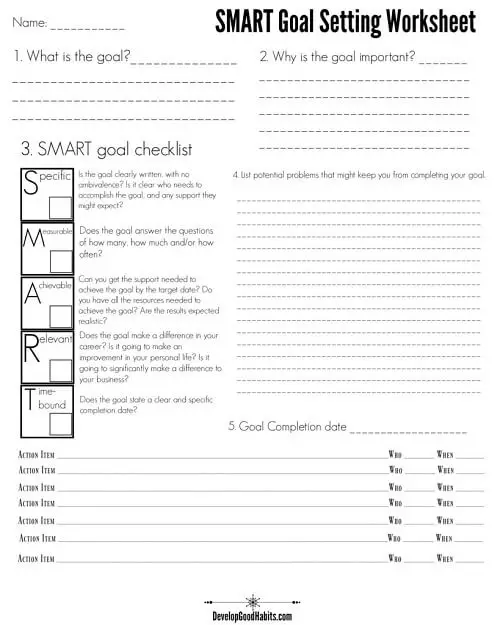
These four SMART goals worksheets and templates from Develop Good Habits boast a clear framework that’s easy to use. You can also use the templates interchangeably.
The download contains:
- Templates for individuals
- A sheet for kids
- Simple worksheet for minimalists
- Templates for multiple goals with multiple steps
SMART Goals Worksheets
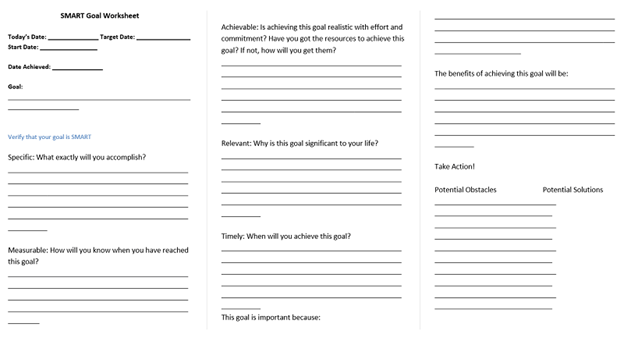
These simple and printable worksheet templates can be used both for Microsoft Excel and Word. They contain guidelines and questions to effectively reach personal and work goals.
SMART Goal Worksheets
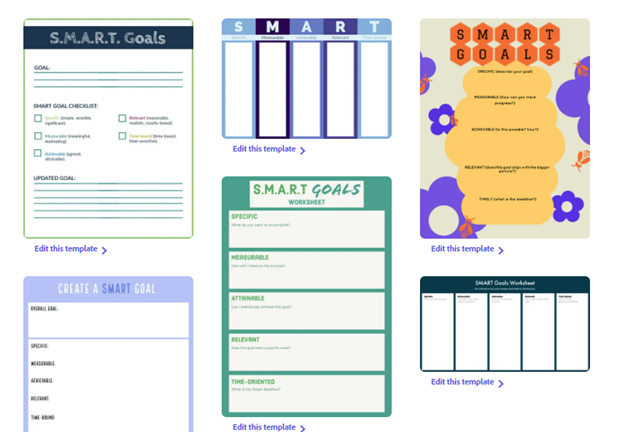
Adobe boasts colorful templates for setting SMART goals more creatively. Users can choose to create original designs from scratch or explore free professionally designed worksheet templates on site. The Adobe template layouts feature fancy backgrounds, icons, images, and animations.
SMART Goals Templates
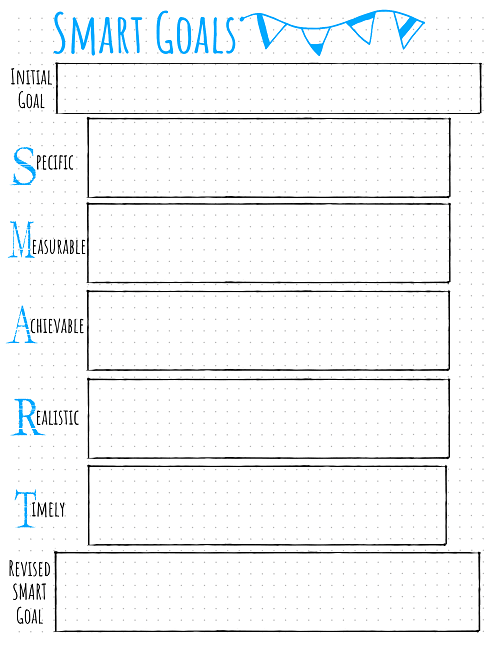
These goal-setting template printables come with action steps and are available in black and white or color (in fillable PDF, Word, or Excel format).
The templates are designed to help you set your goals step by step using action steps. Also, you can customize them (on-site) with additional elements, stickers, or colors.
SMART Goals Templates
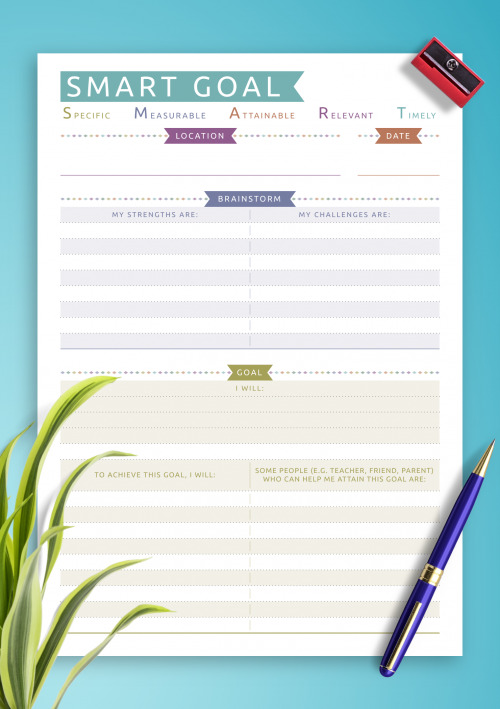
These SMART goal templates are available for download in PDF format. You can choose from simple black and white versions or colorful worksheets. These templates are available as daily and weekly planners, habit trackers, to-do lists, and calendars.
SMART Goals Cheat Sheet Template
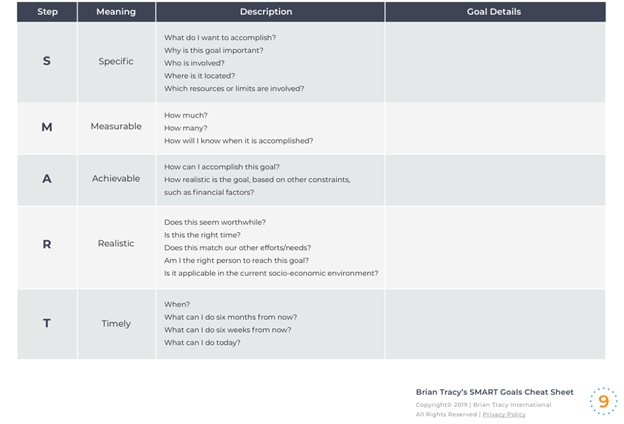
Brian Tracy, the author of Earn What You Are Really Worth, Eat That Frog, and No Excuses! The Power of Self-Discipline and The Psychology of Achievement! created a SMART goals cheat sheet template—with a comprehensive guide on how to write SMART goals. In the template, Tracy gives examples and bonus exercises to plan and achieve anything you want, including your goals and objectives.
SMART Goals Template
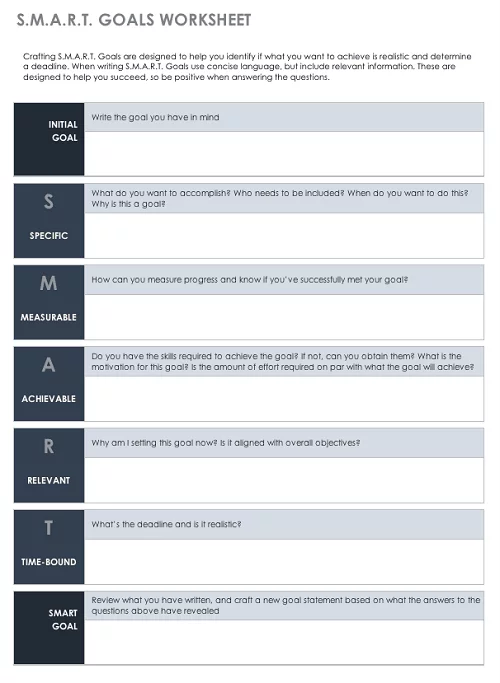
The free SMART goals template from Smartsheet is a simple example of how to set (achievable) SMART goals.
The template boasts questions to help you write down goals you want to achieve. It also illustrates realistic examples that guide you toward achieving success.
Chapter 6: Actionable Ways to Achieve SMART Goals

Achieving your goals isn’t just about setting clear, well-defined goals (and desiring them badly). You need to deploy the right strategies to successfully achieve them.
If you don’t go about deploying the right strategies in the right way, then you won’t see things through—no matter what you want or how badly you think you want it.
Here are ten strategies you can implement to achieve your goals:
1. Chunk Your Goals into Small and Actionable Items
Rather than setting big and urgent goals (such as finding a life partner or buying property) which take time to achieve, start small.
For example, start by setting a goal you can easily accomplish, like learning how to cook or organizing your office or bookshelf.
Breaking down your goals into smaller and actionable steps helps you prioritize which goals are more important to achieve. Also, you’ll have a plan that leads to success.
By achieving small goals first, you’ll be motivated to focus your energy on achieving even more massive results. This level of clarity allows you to measure the progress of your goals, and eventually achieve success.
2. Write Down Your Goals

You have a 42% chance of achieving your goals when you write them down. To easily document your SMART goals, enter them in a Word document, online application, or journal. Then run them through a checklist to ensure they follow the SMART method: Is the goal specific, measurable, attainable, relevant, and time-bound?
3. Align Your Goals With Your Values
Your goals should reflect your character and beliefs on the importance of achieving them; otherwise, you won’t be happy even when you get what you want. Setting a meaningful goal is essential—just make sure you’re clear about the intended consequences of your outcome.
4. Share Your Goals With Key People
Not everyone will benefit from sharing their goals with other people, but it’s important to share them if you have a supportive circle of friends or family. Sharing your progress toward reaching your goals with key people who won’t sabotage your progress is a great move.
5. Track Your Progress Daily
Regularly tracking the progress of your goals helps you know when you’re falling off track. If you’re not moving toward your goal, find out when you fell off the track and took a wrong turn. Tracking your progress regularly helps you catch any changes, giving you a chance to transform the setback into a success.
6. Ensure Your Action Plan Minimizes Potential Challenges
When creating strategies to achieve your goals, it’s tempting to become overconfident and poorly plan the entire process.
To minimize potential challenges along the way, create a measurable action plan with all the steps necessary to achieve your goal. Make sure to integrate your action plan into your schedule, and then evaluate your progress regularly.
As your project takes shape, make adjustments or changes regularly. You should always anticipate changes to avoid getting blindsided.
7. Take Consistent Daily Action
To effectively work toward your goal and objectives, complete at least one action every day. Consistent actions quickly propel you to your goal and motivate you to do even more. For example, you can consistently do small tasks on your to-do list every day that will set you up for success, such as household chores, work tasks, or personal to-dos.
8. Assess Obstacles and Resolve Them Quickly
Bad habits can hold you from achieving your SMART goals. They’ll stifle your progress and get in the way of achieving your hopes and dreams.
If you’re keen on achieving anything worthwhile (especially your goals and objectives), assess and eliminate the bad habits holding you back.
Eliminating obstacles can sometimes be a difficult thing to do. But you can overcome obstacles if you find a reason to move forward that’s stronger than the problem itself—easily illuminating a pathway for eventually reaching your SMART goals.
9. Evaluate and Adjust When Necessary
If you’re serious about achieving your objectives, you need to understand the importance of evaluating and adjusting your SMART goals. It’s the best strategy for setting your goals that’ll result in a high probability of success. As you work toward your goal, remember to constantly evaluate and readjust your plan to achieve it.
10. Celebrate Each Significant Milestone
Every time you achieve a goal, celebrate your win (including the small ones). The joy of winning triggers feel-good hormones, re-energizing your mind and body.
If you achieve your business goals, celebrate the win with your team members. If it’s a personal goal, celebrate with your family and friends. Just don’t forget to get back on track after the celebration. Keep working toward winning the next goal.
Chapter 7: Alternative Acronyms

Almost everyone is familiar with SMART goals—an acronym used since time immemorial by business authors globally to describe the key elements of effective goals.
Just in case you forgot, the SMART acronym stands for goals that are:
- Specific
- Measurable
- Attainable
- Relevant
- Time-bound
However, over the years, SMART goals have failed to keep up with the rapidly growing and more active environment that most organizations find themselves in today.
According to a PwC survey, less than 33% of goals are typically SMART in practice. That means most new and agile organizations require a new way of setting goals—and thus alternative acronyms have proliferated, including:
HARD
In his study, Mark Murphy (founder and CEO of Leadership IQ) revealed that only 15% of employees think SMART goals can help them achieve great things. He discovered HARD goals can light up the brain and encourage great performance.
HARD stands for:
- Heartfelt: Have deep-seated and personal reasons why you want to achieve your goals.
- Animated: Goals should be visualized and take you where you want your career to be and describe what you’re doing.
- Required: Have something or someone help you achieve your goals.
- Difficult: Have the necessary skills to help you accomplish your goals.
CLEAR
Adam Kreek crafted the acronym CLEAR as a rule to support his higher goal (of crossing the Atlantic). Though his boat capsized in the grueling sea, the CLEAR framework united his team members rather than dividing them.
Kreek states that when you set a goal—whether in life, career or business—make it clear enough for you and your team to quickly embrace and act upon.
CLEAR stands for:
- Collaborative: Goals should push employees to collaborate as a team.
- Limited: Goals should have a limit in duration and scope.
- Emotional: Goals should emotionally connect to employees and tap into their passion and energy levels.
- Appreciable: Break down large goals into manageable goals to accomplish them quickly and easily for the long term.
- Refinable: Set goals with a solid objective in mind, but when situations change, refine and modify your goals.
CPQQRT
This acronym leans more toward clearly articulating your plans, activity, and tasks. The CPQQRT method leads to a greater level of understanding and clarity between the task giver and task receiver in an organization—attracting effective results.
CPQQRT stands for:
- Context: Find out how the task (or goal) came to be and how it fits into the bigger picture.
- Purpose: Discover ways you’ll achieve your tasks or goal.
- Quality: Is it something that needs to be all-inclusive or is it just a quick activity?
- Quantity: What does the task output look like?
- Resources: What resources are available to support the completion of your task?
- Time: When do you expect to complete the task?
SMARTER
The SMARTER method helps you set relevant and realistic objectives and actionable goals that you can evaluate and readjust as you progress.
SMARTER stands for:
- Specific: Goals should clearly explain what, why, who, where, and when.
- Measurable: Track and measure the results of your goals.
- Achievable: Set realistic and achievable goals.
- Relevant: Have a reason for setting and achieving your goal.
- Timely: Set a deadline for your goals.
- Evaluate: Evaluate the progress of your goal daily, weekly, or monthly.
- Readjust: If there’s a continuous problem with your goals, just take a step back and readjust your goal-setting process.
PURE
Unlike other methods, the PURE method is a more analytic and pragmatic approach for scoring product usability. It heavily relies on experts making judgments on difficult steps a user makes to complete essential tasks.
PURE stands for practical, usability, rating by experts.
https://www.youtube.com/watch?v=xnE9-QumKKE&t=21s “embed video from 0:00 mins to 0:30 mins”
SMEAC
The SMEAC method is commonly used in the military. This system is designed to document military orders and instructions for field operations so that soldiers can effectively pass information to other troops.
SMEAC stands for:
- Situation: This is a description of what has happened or a background to your problem. Find out the events leading up to where you are now.
- Mission: Now that you know what happened, your mission is to know what you need to do about it.
- Execution: How are you going to achieve your mission? Detail your steps.
- Administration and Logistics: What are the resources you need to do the job? How will the resources be coordinated?
- Command and Communications: Find out who is in charge, who will you report to, and how will you communicate with each other.
Chapter 8: SMART Goals vs. OKRs
SMART goals and OKRs (objectives and key results) are the two common methods of defining goals for an individual, project, or organization.
In an excerpt from his book, Measure What Matters, John Doerr (venture capitalist and billionaire investor) describes introducing OKRs to Stanford grad school dropouts Sergey Brin and Larry Page (the founders of Google) nearly twenty years ago.
His OKRs strategy was simple: “I will [objective] as measured by [key results].”
The crucial part of the strategy “as measured by” revealed that without measuring your goal there’s no way of knowing whether that goal is achievable.
Years later, many multinational companies and startups adopted the OKRs strategy, including Google, Amazon, Adobe, LinkedIn, Microsoft, Netflix, and Twitter.
Notably, SMART goals are comparable to the OKR’s “key results” part, but how are these methods different (and how do they work together)?
How Do OKRs Work?
A good OKR strategy boasts two key elements: an objective and key result(s).
An objective is more of a destination or where you or your company is headed next. This essential element often answers the “Where do I want to go?” question.
For example, John Doerr’s Deck objective (as seen in the video) was “to develop a workable model for planning.” This is a well-defined and specific objective.
To put it another way:
- Objectives set a clear direction that you can follow.
- Objectives inspire you to keep going.
- Objectives aren’t made up of numbers.
That said, key results can measure and track the progress (or success) of an objective. And they often answer the “How will I get there?” question.
In the same example, Doerr’s main objective was measured by three key results:
- Finishing the presentation on time.
- Completing a sample set of three months of OKRs.
- Having management agree to institute a trial system for three months.
In essence, key results are not things you do, like completing projects or launching products, but things you can (easily) influence. Another good example of a key result is “achieving 200 website leads every month.”
What Do OKRs and SMART Goals Have in Common?
OKRs and SMART goals share a common history, tracing their origins back to the most widely held theory: management by objectives (MBO).
This theory played a key role in the recognition of management as a profession, and was first popularized in the 1954 book The Practice of Management by the father of corporate management Peter Drucker.
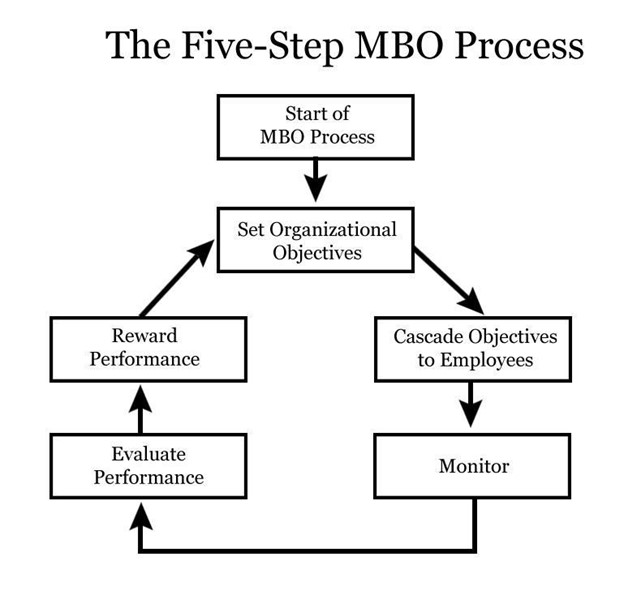
Six decades after publication, the book remains relevant for its original, profound, and timeless ideas—never mind that it has served managers globally ever since.
Both SMART goals and OKRs are a result of effective MBO, and they support the belief that goals are the keys to achieving organizational objectives (and success).
Another common factor is that both methodologies consist of the same number of criteria that describe their framework.
In other words, OKRs are also:
- Specific: They specify what achieving an objective means.
- Measurable: OKRs metrics measure the success of an objective.
- Achievable: You can achieve OKRs with the time and resources you have available, but to achieve excellent results, set ambitious OKR targets.
- Relevant: All OKRs align to higher-level OKRs, making sure teams are working toward the organization’s success.
- Time-bound: Each OKR has a deadline. For example, group OKRs last a quarter of a year, and company OKRs last for a year.
OKRs and SMART goals are also similar in that they both don’t have commercial certification requirements like SCRUM or Six Sigma or a governing body.
Both frameworks are open source.
That means SMART goals and OKRs were created and refined by many different organizations for years on end, testing what works and doesn’t.
This is different from other management frameworks, which are deeply rooted in professional organizations, government, and academia.
The Differences Between OKRs and SMART Goals
On the surface, both methods are similar. For example, they have the same rules that help set objectives, deadlines, and alignment—and they even share a framework.
However, that’s where the similarities end.
SMART goals method is a simple “mnemonic” acronym and criteria to describe its framework—and also it views goals in isolation.
OKR is different. It has a structure that separates the goal’s objectives (what you want to achieve) and how to measure success (or progress) using key results.
OKRs structure highlights the importance of the measurement of progress. But the acronym “M” in SMART goals can throw you off, especially when there are several variations of what the acronym means.
For instance, the “M” can sometimes mean motivational, meaningful, or measurable. Swapping the acronym potentially alters the framework and focus of SMART goals.
With OKRs, a goal will always consist of an objective and key results. There’s no room for interpretations other than the original one.
Chapter 9: SMART Goal FAQs Answered
Here are frequently asked questions (FAQs) concerning SMART goals.

1. Why Should I Use SMART Goals?
It takes time to create an extraordinary life, and even more time to achieve our deep-seated dreams. Since SMART goals are measurable, you can track the progress you’re making. They also give you achievable timelines, allowing you to celebrate your success and inspire you to keep going.
2. How Do I Set Goals That Matter?
Use the SMART goals framework. To set SMART goals, have the right objectives in mind. Rather than saying “I want to make more money,” set a specific goal and find out why you want to make more money—and how you’re going to get there.
To set life-changing SMART goals, know what’s not working in your life. For example, are you distressed about your severed relationship? Is your unhealthy lifestyle killing your joy? Use SMART goals to address all these areas in your life.
3. What Happens if I Get off Track?
Setting SMART goals is more about progress rather than perfection. You’ll fail at some point when trying to follow through with your SMART goals, and that’s okay.
When that happens, begin your goal-setting process yet again. Then tweak and improve where necessary. To get back on track successfully, just focus on the fundamentals of setting goals (as put in the SMART goal framework).
4. Why Am I Not Achieving My SMART Goals?
There are two reasons why you’re not achieving your SMART goals: You’ve either failed to follow steps of the SMART goal-setting process, or you’ve chosen the wrong goals.
Then again, you may have failed to achieve your goals because something much better awaits you. Whatever the reason, when you focus on what is happening for you (rather than to you), the meaning of failure gradually changes to opportunity.
5. What’s the Average Time Frame for SMART Goals?
You can set any deadline for your SMART goals, but the most common is one year—which is plenty of time to improve your goals and make adjustments if you fail to achieve them (as expected).
If you’re setting personal or professional SMART goals, aim for steady progress to get an ideal outcome (achieving your set goals). Remember, SMART goals are meant to achieve actionable results such as improving the efficiency of your business.
6. Can I Do the SMART Goal–Setting Process Alone?
The best way to achieve SMART goals is to surround yourself with supportive people. So, get your colleagues, family members, and friends to help you on your quest, or hire a coach or work with mentors to help you with the SMART goal-setting process.
Setting SMART goals is just half the journey. You can change your life one step at a time. And that starts with writing down the ambitious goals you have in mind and then keenly following the SMART goal framework.
Chapter 10: Let SweetProcess Help You Set and Achieve Your SMART Goals
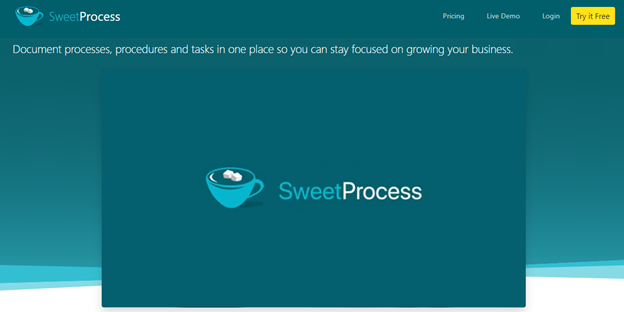
Goal setting is important in every stage of a business. If you’re not working toward a goal, your business will stagnate and eventually fail. Your SMART goals should grow and change your business and even help streamline operations.
SweetProcess helps you create, track, and achieve your most ambitious SMART goals. You can easily break down high-level objectives into smaller, measurable targets on the SweetProcess platform so you can stay focused on growing your business.
Here are examples of how SweetProcess helped businesses achieve their SMART goals.
How an IT Company Achieved Its SMART Goals Using SweetProcess
TechQuarters, an IT company that helps businesses take advantage of cloud solutions to meet their IT needs, needed a strong system to manage its growth and measure performance along the way.
With more customers to cater to, TechQuarters found that documenting their SMART goals and processes manually became tedious and time-consuming. They needed an application to help them set and achieve their goal of streamlining their operations.
Choosing the flexibility of SweetProcess was the best option.
According to Mark O’Dell, the operations director at TechQuarters:
“[SweetProcess] allowed [TechQuarters] to bring different types of media and different bits and pieces into the system. It wasn’t just a simple checklist thing. It allowed [TechQuarters] to nest inside it.”
SweetProcess raised the performance bar at the company, pushing positive results. They could now set SMART goals that effectively improved processes and procedures that employees were happy to use, making their jobs easier.
A Brewing Company Used SweetProcess to Achieve Its SMART Goals of Updating Work Processes and Procedures
Stone & Wood, a brewing company that produces quality beer from its Australian home, needed a better and effective system to update its procedures and maintain quality, which was a top priority for the organization.
To achieve those SMART goals required streamlining production and following processes to the letter. After trying several systems, Thomas Parker—quality assurance & sensory coordinator at Stone & Wood—found the solution in SweetProcess.
“I did look at several different options online. I can’t recall the specifics, but ultimately, it did boil down to a couple, and I liked SweetProcess from its ease of use and how flexible the sign-up was.”
By adopting SweetProcess, Stone & Wood was able to set and achieve its SMART goals by enhancing its human resources and strengthening operations. The software was easy to use, a top criterion on Thomas’s list.
A US-Based Agency Used SweetProcess to Achieve Its Goals of Overhauling Its Manual Processes
The Texas Department of Family and Protective Services (DFPS), an agency focused on family-related services, was desperate to systemize its processes to meet the demands of the job (which included processing over 40,000 records a year).
Their manual processes involved a lot of back and forth that made their work complex. The agency set out to keep its information organized and updated.
That’s how Heather MacLean—a management analyst at DFPS—embarked on a search for a more effective application to achieve their SMART goals. When they found SweetProcess, the agency knew it was the one due to its unique features.
“[Choosing SweetProcess yielded success] because it lets you build a process machine. It’s not just another place to store a book of processes. It lets you plug everything in so that it’s all cohesive and yet independent.”
SweetProcess simply helped the US-based agency to position itself to serve the public better, and achieve its SMART goals of streamlining operations.
The same opportunity is open to you and your business. You can set and achieve your personal and professional SMART goals by adopting SweetProcess today. Sign up for a 14-day FREE trial right away. No credit card required.
Conclusion: Make Your Goals SMART, Sweet, and Successful
Peter Drucker, the father of modern management theory hailed for revolutionizing the perception of business management, once said: “What gets measured gets done.”
The SMART goals framework perfectly summarizes Drucker’s statement.
It also informs you (and your team) what exactly needs to be done, what would be the likely result, and the deadline for achieving the same.
If you jot down your SMART goals and follow the steps to achieve them, odds are, you’ll attract success—and remain focused on your personal and business goals.
But SMART goals only work if you start them.
So decide today what your goals are. Then break them down into measurable steps and create SMART goals to help you achieve those steps.
Before long, you’ll have a clear path that pinpoints exactly where you are today and where you want to be in the next five (or more) years.
